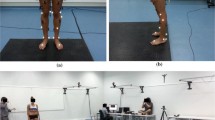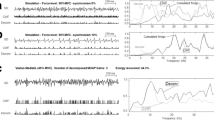Abstract
This paper relates to the use of knowledge-based signal processing techniques in the decomposition of EMG signals. The aim of the research is to automatically decompose EMG signals recorded at force levels up to 20 per cent maximum voluntary contraction (MVC) into their constitutent motor unit action potentials (MUAPS), and to display the MUAP shapes and firing times for the clinician. This requires the classification of nonoverlapping MUAPs and superimposed waveforms formed from overlapping MUAPs in the signal. Nonoverlapping MUAPs are classified using a statistical pattern-recognition method. The decomposition of superimposed waveforms uses a combination of procedural and knowledge-based methods. The decomposition method was tested on real and simulated EMG data recorded at force levels up to 20 per cent MVC. The different EMG signals contained up to six motor units (MUs). The new decomposition program classifies the total number of MUAP firings in an EMG signal with an accuracy always greater than 95 per cent. The decomposition program takes about 15 s to classify all nonoverlapping MUAPs in EMG signal of length 1·0 s and, on average, an extra 9s to classify each superimposed waveform.
Similar content being viewed by others
References
Andreassen, S. andRosenfalck, A. (1980) A regulation of the firing patterns of single motor units.J. Neurol., Neurosurg., & Psychiat.,33, 897–906.
Basmajian, J. V. andDeLuca, C. J. (1985)Muscles alive. The Williams & Wilkins Co.
Bhullar, H. K., Loudon, G. H., Fothergill, J. C. andJones, N. B. (1990) Selective noninvasive electrode to study myoelectric signals.Med. & Biol. Eng. & Comput.,28, 581–586.
Gerber, A. andStuder, R. M. (1984) A new framework and computer program for quantitative EMG signal analysis.IEEE Trans.,BME-31, 857–863.
Gorsuch, R. L. (1974)Factor analysis. W. B. Saunders Co.
Hunter, J. E. (1972) Maximal decomposition.Multivariate Behavioral Res.,7, p. 243.
LeFever, R. S. andDeLuca, C. J. (1982) Procedure for decomposing the myoelectric signal into its constituent action potentials.IEEE Trans.,BME-29, 149–162.
Mambrito, B. andDeLuca, C. J. (1984) A technique for the detection, decomposition and analysis of the EMG signal.Electroenceph. & Clin. Neurophysiol.,58, 175–188.
McGill, K. C., Cummins, K. L. andDorfman, L. J. (1985) Automatic decomposition of the clinical electromyogram.IEEE Trans.,BME-32, 470–477.
Nandedkar, S. D. andSanders, D. B. (1989) Median averaging of electromyographic motor unit action potentials: comparison with other techniques.Med. & Biol. Eng. & Comput.,27, 566–571.
Sehmi, A. S. andJones, N. B. (1989) Intelligent Interpretation of Evoked Potentials. Proc. IFAC-BME89 Workshop in Decision Support for Patient Management: Measurement, Modelling and Control, City University, London, Sept. 1989, 136–150.
Tryon, R. C. andBailey, D. E. (1970)Cluster analysis. McGraw Hill.
Author information
Authors and Affiliations
Rights and permissions
About this article
Cite this article
Loudon, G.H., Jones, N.B. & Sehmi, A.S. New signal processing techniques for the decomposition of EMG signals. Med. Biol. Eng. Comput. 30, 591–599 (1992). https://doi.org/10.1007/BF02446790
Received:
Accepted:
Issue Date:
DOI: https://doi.org/10.1007/BF02446790




